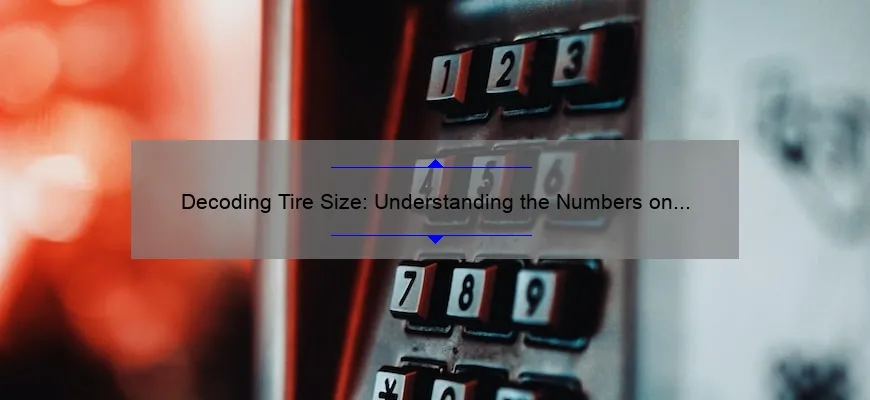Short answer: What do the numbers on tire size mean?
Tire size is indicated by a series of numbers on the sidewall. The first number indicates the width of the tire in millimeters, followed by the aspect ratio which shows the height as a percentage of width. The letter after this represents the construction type, such as radial or bias-ply. Finally, the last numbers stand for rim diameter in inches.
A Step-by-Step Guide to Decoding Tire Size: What Do the Numbers Really Mean?
Have you ever found yourself staring at the mysterious numbers and letters on your tire, wondering what they mean? Well, fear not – decoding a tire size is actually quite simple once you know what to look for. In this step-by-step guide, we’ll walk you through each component of a typical tire size code so you can understand it in plain English.
First up: the basics. Tire sizes are typically expressed as three groups of numbers separated by slashes. For example, a common tire size might be written as P215/60R16. The first group indicates the section width of the tire (in millimeters) when mounted on a rim of specified width. So in our example above, that would be 215mm.
The second number indicates the aspect ratio or profile height – essentially how tall or short the sidewall is relative to the section width. This is expressed as a percentage; in other words, if an aspect ratio is listed as 60, that means that the height of the sidewall is equal to 60% of its width (or about 129mm).
Next comes something called “load index,” which tells you how much weight each individual tire can support. This figure ranges from around 70-120 (although some tires may have lower or higher ratings). Generally speaking, higher load indexes equate to heavier-duty tires that can handle more cargo or towing weight.
Finally, there’s speed rating – another important factor to consider when buying new tires since it relates directly to performance capabilities and safety considerations while driving at high speeds over extended periods.
Speed rating codes range from A (the lowest) all all way up ZR8+ (ie highest possible—more than sufficient for street use), with each letter corresponding roughly approximating max vehicle speed endurance capacity.. You’ll want equipment identical–exactly! To ensure safe compatibility across your selected driving experiences & goals!
So now that we’ve broken down the individual components of a tire size – section width, aspect ratio/profile height, load index and speed rating – we hope that this step-by-step guide has been helpful in decoding these numbers. When it comes to selecting new tires for your vehicle, understanding what each component means can go a long way in helping you make an informed decision. Make sure any information before purchasing equipment—such as from reputable professionals like those found onboard at mechanic garages!
Frequently Asked Questions About Tire Size: What Do Those Numbers Signify?
Have you ever looked at your tires and wondered what all those numbers and letters mean? Tire size can be confusing to some, but it’s important to understand the meaning behind those seemingly random symbols. Here are some frequently asked questions about tire size:
1. What do the numbers on the sidewall of my tire stand for?
The numbers on a tire’s sidewall represent its size, construction type, maximum load-carrying capacity, speed rating, and other significant details. The format usually includes three sets of characters that signify different things. For example: P215/70R16 99T.
– The first letter indicates whether the tire is designated for passenger (P), light truck (LT), or temporary spare use (T).
– The following number identifies the width of the tire from one sidewall to another in millimeters.
– After that comes a slash (/) which separates the width from the aspect ratio – this refers to the height of the sidewall as a percentage of its total section width.
– R means radial ply construction; B stands for belted bias-ply; D is diagonal bias-ply; TD or TDR stands for Temporary Spare Radial/Diagonal.
– Next two digits indicate wheel diameter in inches
– Load index shows how much weight per tyre manufacturer recommendations,
-Tire Speed Rating tells us upto what speed that particular tyre perform efficiently.
2. Can I change my tire size?
It’s possible to deviate slightly from your original equipment sizes if you ensure they find compatible with vehicle specifications as recommend by manufacturing companies practice guide lines Some car enthusiasts also enjoy customizing their wheels selections because aftermarket upgrades often improve performance capabilities..
3. Will changing my tire size affect anything else on my vehicle such as Speedometer accuracy or fuel economy?
Yes there will be definitely an impact When replacing tyres with differing diameters affects speedometer etc With larger tires-than recommended affecting fuel efficiency too hence always when making changes it is recommendable to follow the specifications set forth by the manufacturer.
4. What are Plus-Sizing or Minus-Sizing tires?
Plus-sizing refers to increasing overall tyre diameter in order for wheel-and-tire sets larger, facilitating performance benefits like better handling around sharp corners& improved braking system enhancements .This upgrades package available enabling vehicle owners looking for improvement minium changes however it’s important remember proper fitting recommended.
On other hand minus size tires associated with smaller between than standard sizes aimed at benefitting fuel efficiency rotating weight reduction also providing smoother ride based on particular car customized needs..
5. Does tire brand matter?
There many brands of tyres available which vary depending upon quality, warranty and price range.Some people believe that more expensive tires are superior but this isn’t always true as some are cheaper yet provide same level functionalities hence its crucial reading reviews along matching specs before investing money .
In conclusion understanding tire sizes can make a big difference when you need replacements.. It’s essential to know what factors into them so as not become confused indecisive during buying process. Don’t hesitate reaching out automotive technicians for expert guidance if unsure – happy driving!
Top 5 Facts You Need to Know About Understanding Tire Size and the Numbers Involved
As a driver, it’s important to understand the tire size and numbers involved when purchasing new tires or simply checking your old ones. Tire sizing may appear complicated at first glance, but with our top 5 facts explained in simple terms, you’ll be able to decode this information like a pro!
1. The First Number is Always Width
The three numbers on the side of your tire indicate its width, aspect ratio (height), and diameter respectively. The first number always represents the width of the tire measured in millimeters from sidewall-to-sidewall when mounted on a rim rated for that specific width.
For example: A tire labeled as “215/55/R17” means that the tire has a width of 215mm from one sidewall to another – approximately eight and a half inches.
2. What Does Aspect Ratio Mean?
The next number after the forward slash (“/”) indicates height or aspect ratio shown as a percentage of its section’s nominal dimension (width). This value signifies how tall or short-walled/high profiled is your tire compared to its relative body-size rather than measuring it directly.
For instance: If you have “215/65/R17” written on your car’s tires so here 65 shows proportionately ninety percent higher wall protrusion over two hundred fifteen mm splaying across those rubber sides onto which external factors rub against while driving around Canada’s harsh weather conditions can take their toll among other things such bumps etc., making these components more prone towards vehicular damage will cause braking issues too ultimately specifying exact replacement needs if required subsequently upon wear throughout vehicle lifetime by acquiring suitable replacements based upon proportional ratios listed through sales pitches via online stores once necessary research regarding relevant model compatibility becomes evident conducive purchase processes prove successful otherwise incompatible models could result in hazardous scenarios warranting expensive services associated parts eventually leading towards diminished vehicle safety ratings.
3. Radial vs Bias Ply Tires
Radial refers to the manner in which the tire is manufactured, with plies running from bead to bead at a 90-degree angle to the tread. Bias ply tires are made up of overlapping layers of cord material laid across the tire from sidewall to sidewall at an angle.
In short: Radial tires tend to offer better handling and greater fuel efficiency while bias-ply tires may be preferable for heavy-duty applications such as hauling or off-roading due to their more rugged construction.
4. The Rim Diameter is Critical
The number following “R” represents rim diameter measured in inches. This value tells you how large your wheel will fit onto without risking getting damaged – obviously important when upgrading your wheels – because purchasing incompatible replacements beyond limitations usually stipulated by manufacturers can cause handlings issues while driving though exceptions may apply especially if particular makes/models come equipped according specifications found even reputed brands cater higher end vehicles using custom parts based upon vehicle owner’s preferences towards luxury etc., thereby compromising warranty assurances during installments.
For example: A car that comes stock with 15-inch rims cannot fit anything larger than a 15” wheel safely on its original components so buying any bigger alloys could result in catastrophe leading inevitable breakage or malfunctioning symptoms over time thus warranting potential accidents put driver passengers’ lives risk overall safety factors lower dramatically creating quite unsafe scenarios within swift changing times automobile technology demands stringent adherences guidelines rules regulations regarding manufacturing practices designs materials quality control mechanisms implemented sustainable values ensure safe travels consumers worldwide sometimes demanding radical shifts technological innovations create conducive purchasing power directed these urges relentless trends shaping industry standards today tomorrow alike keeping abreast current developments imperative survival exploration possibilities amidst uncharted territories yet unexplored preserve sanctity vehicular properties occupants entrusted occasionally oblivious facades hidden uncertainties behind veil transparency vital preludes informed decisions jointly steering prosperous economies common goals promoting development advancements welfare societies levels upward spiral reflect positivity achieved providing customers satisfaction security belief bond retaining loyal customer bases withstand challenges magnitude.
5. Speed Index
The last letter in the sequence is the speed rating, indicating how fast you can safely drive with that tire under ideal conditions (dry pavement, normal temperature). This value goes from A to Z and covers up to 186 mph. The higher-rated tires typically have firmer sidewalls for better handling at high speeds but tread life may decrease gradually contributing towards shorter operating costs whether individual commutes making long haul experts dealing heavy loads over extended periods adapting lifestyles around these dimensions necessary more often than not affecting economies scales mass production sales etc.
In summary, understanding your tire size and numbers involved doesn’t need to feel overwhelming or complicated anymore! Remembering these top five facts will help you pick out the right set of tires for your car while also ensuring a safer driving experience along any given route in a Canadian region where weather patterns vary drastically depending on location terrain road surfaces traffic conditions amongst multiple influencing factors acting simultaneously upon vehicular components driven therein by alert adaptive motorists seeking optimal outcomes regarding their travel needs fuel economy mileage standards optimized performances cost-effectiveness longevity durability compliance governmental norms regulations towards environmental societal factors aligned priorities thereby creating conducive environments wherein everyone wins








